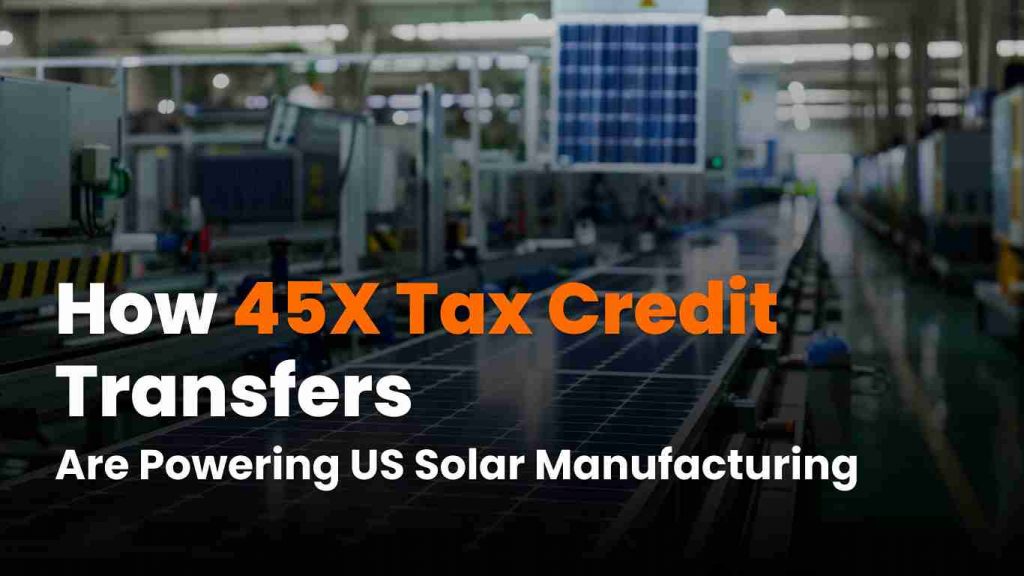The Inflation Reduction Act (IRA) has significantly reshaped the solar industry, offering financial incentives to make solar projects more viable. One of the most impactful provisions is the tax credit transferability option, which has made financing solar ventures easier and provided new opportunities for investment. Now, this same provision is strengthening U.S. solar manufacturing by maximizing the benefits of the 45X Advanced Manufacturing Production Credit.
What is the 45X tax credit?
The 45X tax credit is a key incentive for domestic manufacturers producing eligible solar and storage components such as panels, trackers, inverters, and batteries. Full credit benefits are available through December 31, 2029, before gradually phasing down. This incentive is designed to boost the production of solar equipment within the U.S., reducing reliance on foreign imports and creating a more robust domestic supply chain.
However, the upfront costs of establishing solar manufacturing facilities can be steep. The 45X credit helps bridge this financial gap, allowing companies to either claim the credit at tax time or receive immediate cash through the tax credit transfer market.
How does tax credit transferability work?
Before the IRA, tax credits were non-transferable, meaning only companies with sufficient tax liability could benefit. With transferability, companies can now sell their credits to entities looking to reduce their tax burdens, effectively converting tax credits into liquid capital. This is particularly beneficial for solar manufacturers needing upfront funding for operations and expansion.
According to Erik Underwood, co-founder and CEO of renewable energy tax credit marketplace Basis Climate, transferability is helping solar manufacturers secure loans by strengthening their financial case. “These companies need significant upfront capital to expand. Being able to sell 45X credits as part of their cash flow strategy improves their financial outlook and ability to grow,” he explains.
Real-world impact: companies benefiting from 45X transfers
Heliene
Canadian solar panel manufacturer Heliene has leveraged 45X credit sales to support its U.S. operations. The company used proceeds from selling its 2023 and 2024 45X credits—totaling $50 million—as collateral for financing its working capital. “Even if you have to discount a few pennies on the dollar, selling these credits is a better deal than paying high-interest rates on loans,” says Heliene CEO Martin Pochtaruk. Heliene is now seeking buyers for its 2025 credits to continue its growth.
SolarEdge
Inverter manufacturer SolarEdge also took advantage of 45X transfers, selling its 2024 credits for $40 million. The company views this as an efficient way to offset corporate taxes while securing short-term liquidity. “For a public company like ours, having cash on hand is critical. Selling 45X credits allows us to reinvest in operations immediately instead of waiting for tax season,” explains J.B. Lowe, head of investor relations at SolarEdge.
First Solar’s Record-Breaking Sale
First Solar made headlines with the largest publicized 45X transfer to date, selling $700 million worth of credits to financial services firm Fiserv at a rate of 96 cents per dollar. CEO Mark Widmar emphasized that this move aligns with the IRA’s goal of supporting high-value domestic manufacturing. “This agreement confirms the marketability of 45X credits and underscores their importance in driving U.S. solar production,” Widmar stated.
Why buyers are interested in 45X credits
The ability to purchase 45X credits has attracted major corporations looking to lower tax liabilities while supporting renewable energy. For example, electronics manufacturer Schneider Electric, which produces inverters and smart meters for the residential solar market, has acquired 45X credits from Silfab.
“45X is more than just a financial incentive; it’s about job creation and strengthening the solar supply chain within the U.S.,” says Emily Rose, Schneider’s associate director of renewable energy investments. “We wanted to invest in something that aligns with our sustainability mission.”
Additionally, some buyers prefer production-based tax credits like 45X over investment-based credits due to their lower risk profile. “Many buyers like that 45X credits directly support manufacturing and have a more predictable value,” notes Underwood.
The future of 45X under a changing political landscape
Despite its success, the future of the 45X credit remains uncertain under the new Trump administration, which is expected to prioritize oil and gas interests. Some members of Congress have proposed restrictions on 45X eligibility for companies with ties to China, which could impact certain manufacturers.
However, industry leaders believe the transferability provision itself is unlikely to be repealed. “It’s the most free-market aspect of tax credits,” says Schneider’s Rose. “It supports American job growth and manufacturing, which makes it a politically attractive policy.”
For now, buyers and sellers continue to take advantage of 45X credits, with many planning ahead for 2026 transactions. “Companies should act now to strategize their tax positions and lock in deals while the policy remains stable,” Underwood advises.
Strengthening US solar manufacturing through 45X transfers
The transferability of the 45X tax credit is proving to be a game-changer for U.S. solar manufacturing. By allowing companies to sell credits and receive immediate capital, it helps manufacturers scale their operations, create jobs, and support domestic solar supply chains. Meanwhile, buyers benefit from tax savings while contributing to the growth of renewable energy.
As long as the policy remains intact, the 45X credit will continue to play a crucial role in expanding U.S. solar manufacturing, making clean energy more accessible and strengthening the country’s energy independence.

